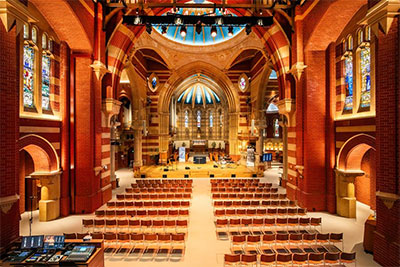To mark its bicentennial, St John’s Anglican church in Tasmania committee undertook a major revision of its sound system, largely to enhance speech intelligibility. Guz Box design+audio oversaw both the acoustic and electro-acoustic design works.
Dating to 1824, St John’s is the oldest church in Launceston. Plans for its upgrade were begun in 2020, but hampered by Covid restrictions it wasn’t until post-pandemic that the Canberra-based consultant fully realised the overwhelming number of architectural constraints the heritage-listed building presented – not least the acoustic, with multiple reflections created by a 22m-high dome.
 The reason intelligibility was such a concern was that many of the congregants are elderly, struggling to understand spoken word services. The existing loudspeaker system simply did not meet their needs, as it consisted of too many non-compatible enclosures, randomly installed as extensions had been added over time.
The reason intelligibility was such a concern was that many of the congregants are elderly, struggling to understand spoken word services. The existing loudspeaker system simply did not meet their needs, as it consisted of too many non-compatible enclosures, randomly installed as extensions had been added over time.
Speech wasn’t the only consideration, as St John’s also hosts contemporary music for itsyouth services, as well as orchestral and pipe organ recitals. After evaluation, Guz Box founder Tim Kuschel’s proposal to improve coverage in the sanctuary, platform and presentation areas came down in favour of Martin Audio’s O-Line micro-array. ‘This offered the most consistent results across the seating,’ he explains. ‘With its compact form factor, O-Line excels in houses of worship where speech intelligibility is the primary function.’
Guz Box arrived at this solution only after completing extensive acoustic measurements using Ease software, to ensure that the loudspeaker energy was focused on the main church seating areas, and that the sound would operate within the full frequency range for speech and music, meeting a desired Speech Transmission Index (STI) and other key parameters.
Kuschel built a model in AutoCAD, converted it into a virtual acoustic model using AFMG Ease v5 and correlated the physical measurements with the Ease model. He also worked with Cumulus Studio by proposing an extensive acoustic works treatment programme, including ceiling absorbers and wall treatments. Ad working with Martin Audio distributor Technical Audio Group (TAG), he detailed two hangs of 16 Martin Audio O-Line elements.
For music, he recognised that additional subwoofers would be required. Thus low-end support is provided by six of Martin Audio’s SX110 10-inch direct radiating sub bass arrays, equally spaced across the front of the stage under the main platform. Each is individually amplified and processed to optimise steering.
However, the installation was not without its challenges. Unable to suspend the main arrays from the 22m-high concrete dome – due to it being 16m higher than the optimum speaker placement – in order to achieve optimum coverage, in line with the modelling prediction the top box of each hang was suspended 6m above the sanctuary floor. This required custom brackets to be fabricated, to extend the distance of the arrays from the wall. The loudspeaker cabling was also concealed within the mounting bracket. ‘It was a pretty neat solution all round,’ Kuschel says.‘The installer did a great job with this.’
Kuschel looked to Martin Audio’s Display 2 software, using its Hard Avoid feature to avoid spill back onto the stage/platform area. In this case, single-element resolution was used for optimised coverage over the audience area.
Further fill loudspeakers have also been used, including several Martin Audio CDD6 and CDD5s, in the side chapel and chancel/choir stalls on ball and ceiling brackets. These were chosen for directional characteristics and form factor.
The O-Line elements (and other Martin Audio loudspeakers) were installed in standard colour finish. Other fixings including cable-runs in conduit were colour-matched where possible to satisfy the heritage requirements of the building.
Other project considerations included independent wireless iPad control for the clergy, enhanced assistive listening, isolation from other interference and advanced acoustic treatment (as well as carpet absorption). The latter included an aesthetic acoustic treatment of Megasorber C50 50mm sound absorbing panels to approximately two-thirds of the ceiling over the main seating areas.
The result is a completed project with all goals met. The reverberant energy over the audience area has been controlled, and the new audio system provides a minimum measured STI value of 0.61 from the front row to the last seat of the balcony – with speech uniformly intelligible throughout. Kuschel has provided intuitive control and management for non-technical staff in whatever mode the system is operating.
He has also struck the right RT60 balance, recording 2.5s reverberation time, mainly in the mid-frequencies. ‘The organist demanded reverberant energy in the space, and it was pleasing to note that this has been unaffected by the acoustic works,’ Kuschel notes. ‘Crucially, the reflected energy has been controlled and so the performance of singers and musicians is not compromised.’
Installation works were carried out by Tasmania-based Contact Group, while T-Built project manager Joel Taylor coordinated and managed all onsite contractors and systems integrators.
More: https://martin-audio.com

